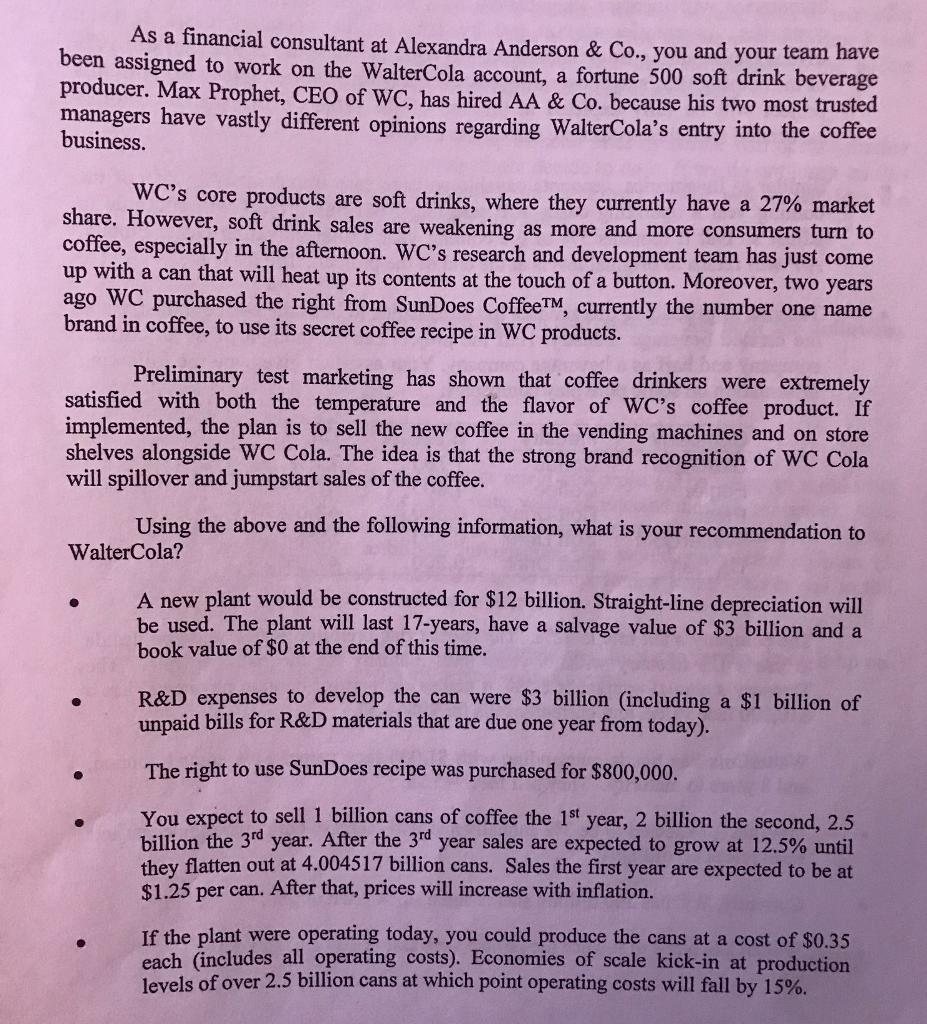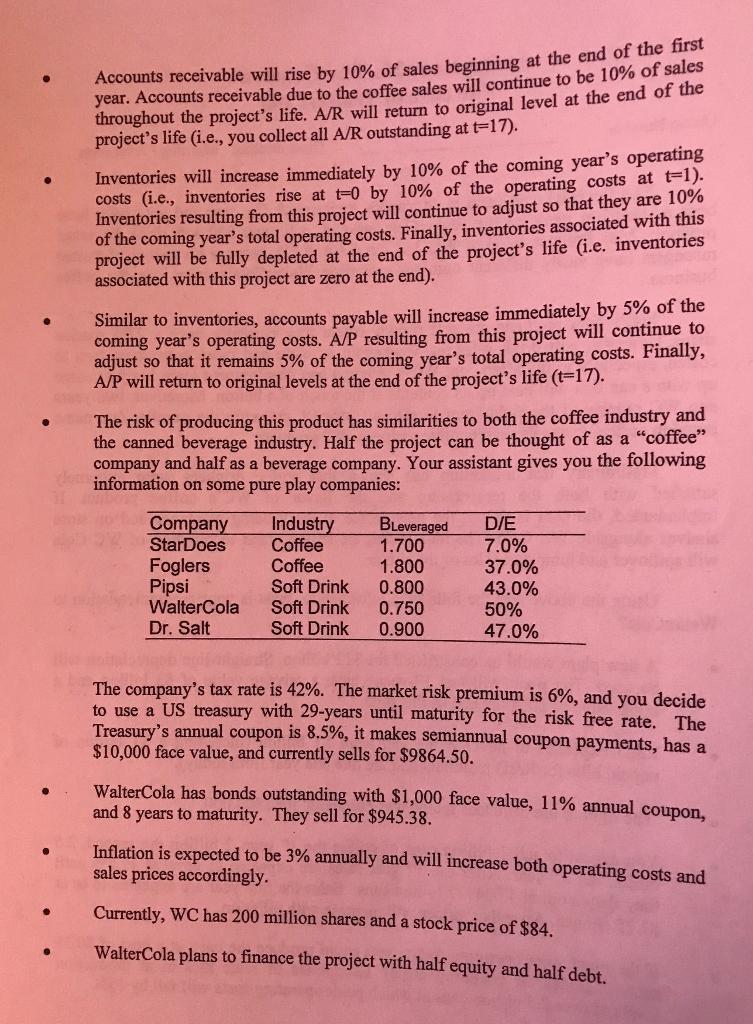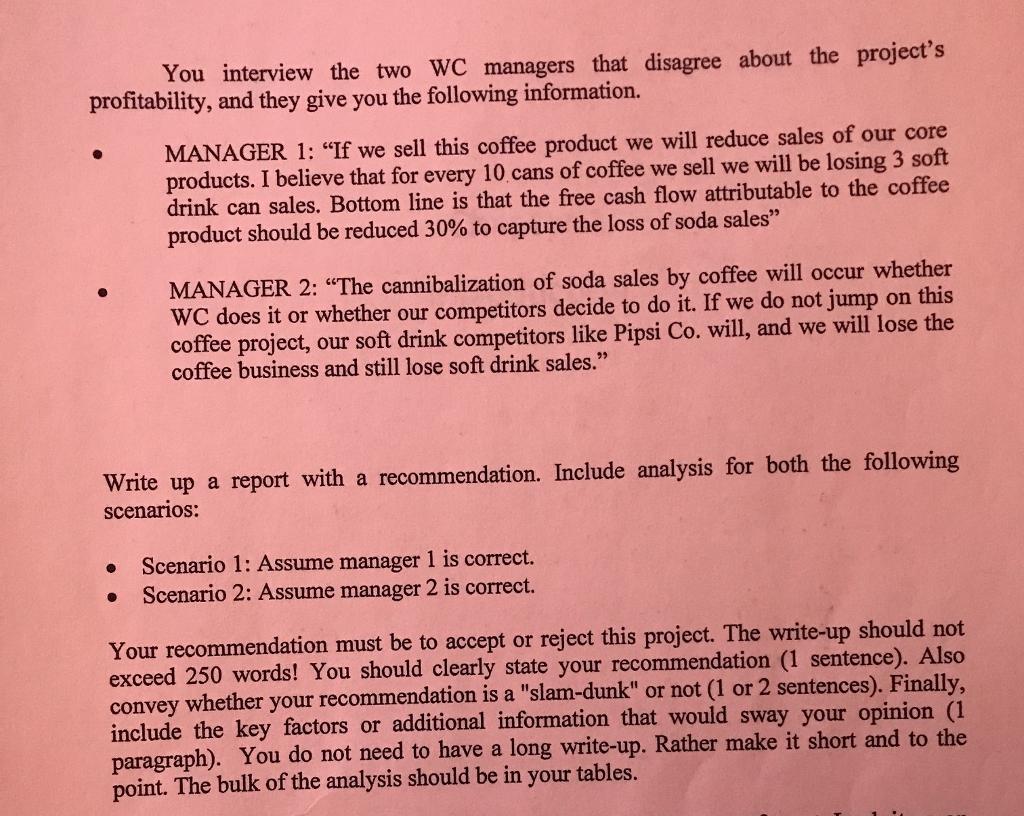Answered step by step
Verified Expert Solution
Question
1 Approved Answer
As a financial consultant at Alexandra Anderson & Co., you and your team have been assigned to work on the WalterCola account, a fortune



As a financial consultant at Alexandra Anderson & Co., you and your team have been assigned to work on the WalterCola account, a fortune 500 soft drink beverage producer. Max Prophet, CEO of WC, has hired AA & Co. because his two most trusted managers have vastly different opinions regarding WalterCola's entry into the coffee business. WC's core products are soft drinks, where they currently have a 27% market share. However, soft drink sales are weakening as more and more consumers turn to coffee, especially in the afternoon. WC's research and development team has just come up with a can that will heat up its contents at the touch of a button. Moreover, two years ago WC purchased the right from SunDoes CoffeeTM, currently the number one name brand in coffee, to use its secret coffee recipe in WC products. Preliminary test marketing has shown that coffee drinkers were extremely satisfied with both the temperature and the flavor of WC's coffee product. If implemented, the plan is to sell the new coffee in the vending machines and on store shelves alongside WC Cola. The idea is that the strong brand recognition of WC Cola will spillover and jumpstart sales of the coffee. Using the above and the following information, what is your recommendation to WalterCola? A new plant would be constructed for $12 billion. Straight-line depreciation will be used. The plant will last 17-years, have a salvage value of $3 billion and a book value of $0 at the end of this time. R&D expenses to develop the can were $3 billion (including a $1 billion of unpaid bills for R&D materials that are due one year from today). The right to use SunDoes recipe was purchased for $800,000. You expect to sell 1 billion cans of coffee the 1st year, 2 billion the second, 2.5 billion the 3rd year. After the 3rd year sales are expected to grow at 12.5% until they flatten out at 4.004517 billion cans. Sales the first year are expected to be at $1.25 per can. After that, prices will increase with inflation. If the plant were operating today, you could produce the cans at a cost of $0.35 each (includes all operating costs). Economies of scale kick-in at production levels of over 2.5 billion cans at which point operating costs will fall by 15%. Accounts receivable will rise by 10% of sales beginning at the end of the first year. Accounts receivable due to the coffee sales will continue to be 10% of sales throughout the project's life. A/R will return to original level at the end of the project's life (i.e., you collect all A/R outstanding at t-17). Inventories will increase immediately by 10% of the coming year's operating costs (i.e., inventories rise at t=0 by 10% of the operating costs at t=1). Inventories resulting from this project will continue to adjust so that they are 10% of the coming year's total operating costs. Finally, inventories associated with this project will be fully depleted at the end of the project's life (i.e. inventories associated with this project are zero at the end). Similar to inventories, accounts payable will increase immediately by 5% of the coming year's operating costs. A/P resulting from this project will continue to adjust so that it remains 5% of the coming year's total operating costs. Finally, A/P will return to original levels at the end of the project's life (t=17). The risk of producing this product has similarities to both the coffee industry and the canned beverage industry. Half the project can be thought of as a "coffee" company and half as a beverage company. Your assistant gives you the following information on some pure play companies: EETA D/E 7.0% 37.0% 43.0% 50% 47.0% Company StarDoes Foglers Pipsi WalterCola Dr. Salt Industry Coffee Coffee Soft Drink Soft Drink BLeveraged 1.700 1.800 0.800 0.750 0.900 Soft Drink The company's tax rate is 42%. The market risk premium is 6%, and you decide to use a US treasury with 29-years until maturity for the risk free rate. The Treasury's annual coupon is 8.5%, it makes semiannual coupon payments, has a $10,000 face value, and currently sells for $9864.50. WalterCola has bonds outstanding with $1,000 face value, 11% annual coupon, and 8 years to maturity. They sell for $945.38. Inflation is expected to be 3% annually and will increase both operating costs and sales prices accordingly. Currently, WC has 200 million shares and a stock price of $84, WalterCola plans to finance the project with half equity and half debt. You interview the two WC managers that disagree about the project's profitability, and they give you the following information. MANAGER 1: "If we sell this coffee product we will reduce sales of our core products. I believe that for every 10 cans of coffee we sell we will be losing 3 soft drink can sales. Bottom line is that the free cash flow attributable to the coffee product should be reduced 30% to capture the loss of soda sales" MANAGER 2: "The cannibalization of soda sales by coffee will occur whether WC does it or whether our competitors decide to do it. If we do not jump on this coffee project, our soft drink competitors like Pipsi Co. will, and we will lose the coffee business and still lose soft drink sales." Write up a report with a recommendation. Include analysis for both the following scenarios: Scenario 1: Assume manager 1 is correct. Scenario 2: Assume manager 2 is correct. Your recommendation must be to accept or reject this project. The write-up should not exceed 250 words! You should clearly state your recommendation (1 sentence). Also convey whether your recommendation is a "slam-dunk" or not (1 or 2 sentences). Finally, include the key factors or additional information that would sway your opinion (1 paragraph). You do not need to have a long write-up. Rather make it short and to the point. The bulk of the analysis should be in your tables. As a financial consultant at Alexandra Anderson & Co., you and your team have been assigned to work on the WalterCola account, a fortune 500 soft drink beverage producer. Max Prophet, CEO of WC, has hired AA & Co. because his two most trusted managers have vastly different opinions regarding WalterCola's entry into the coffee business. WC's core products are soft drinks, where they currently have a 27% market share. However, soft drink sales are weakening as more and more consumers turn to coffee, especially in the afternoon. WC's research and development team has just come up with a can that will heat up its contents at the touch of a button. Moreover, two years ago WC purchased the right from SunDoes CoffeeTM, currently the number one name brand in coffee, to use its secret coffee recipe in WC products. Preliminary test marketing has shown that coffee drinkers were extremely satisfied with both the temperature and the flavor of WC's coffee product. If implemented, the plan is to sell the new coffee in the vending machines and on store shelves alongside WC Cola. The idea is that the strong brand recognition of WC Cola will spillover and jumpstart sales of the coffee. Using the above and the following information, what is your recommendation to WalterCola? A new plant would be constructed for $12 billion. Straight-line depreciation will be used. The plant will last 17-years, have a salvage value of $3 billion and a book value of $0 at the end of this time. R&D expenses to develop the can were $3 billion (including a $1 billion of unpaid bills for R&D materials that are due one year from today). The right to use SunDoes recipe was purchased for $800,000. You expect to sell 1 billion cans of coffee the 1st year, 2 billion the second, 2.5 billion the 3rd year. After the 3rd year sales are expected to grow at 12.5% until they flatten out at 4.004517 billion cans. Sales the first year are expected to be at $1.25 per can. After that, prices will increase with inflation. If the plant were operating today, you could produce the cans at a cost of $0.35 each (includes all operating costs). Economies of scale kick-in at production levels of over 2.5 billion cans at which point operating costs will fall by 15%. Accounts receivable will rise by 10% of sales beginning at the end of the first year. Accounts receivable due to the coffee sales will continue to be 10% of sales throughout the project's life. A/R will return to original level at the end of the project's life (i.e., you collect all A/R outstanding at t-17). Inventories will increase immediately by 10% of the coming year's operating costs (i.e., inventories rise at t=0 by 10% of the operating costs at t=1). Inventories resulting from this project will continue to adjust so that they are 10% of the coming year's total operating costs. Finally, inventories associated with this project will be fully depleted at the end of the project's life (i.e. inventories associated with this project are zero at the end). Similar to inventories, accounts payable will increase immediately by 5% of the coming year's operating costs. A/P resulting from this project will continue to adjust so that it remains 5% of the coming year's total operating costs. Finally, A/P will return to original levels at the end of the project's life (t=17). The risk of producing this product has similarities to both the coffee industry and the canned beverage industry. Half the project can be thought of as a "coffee" company and half as a beverage company. Your assistant gives you the following information on some pure play companies: EETA D/E 7.0% 37.0% 43.0% 50% 47.0% Company StarDoes Foglers Pipsi WalterCola Dr. Salt Industry Coffee Coffee Soft Drink Soft Drink BLeveraged 1.700 1.800 0.800 0.750 0.900 Soft Drink The company's tax rate is 42%. The market risk premium is 6%, and you decide to use a US treasury with 29-years until maturity for the risk free rate. The Treasury's annual coupon is 8.5%, it makes semiannual coupon payments, has a $10,000 face value, and currently sells for $9864.50. WalterCola has bonds outstanding with $1,000 face value, 11% annual coupon, and 8 years to maturity. They sell for $945.38. Inflation is expected to be 3% annually and will increase both operating costs and sales prices accordingly. Currently, WC has 200 million shares and a stock price of $84, WalterCola plans to finance the project with half equity and half debt. You interview the two WC managers that disagree about the project's profitability, and they give you the following information. MANAGER 1: "If we sell this coffee product we will reduce sales of our core products. I believe that for every 10 cans of coffee we sell we will be losing 3 soft drink can sales. Bottom line is that the free cash flow attributable to the coffee product should be reduced 30% to capture the loss of soda sales" MANAGER 2: "The cannibalization of soda sales by coffee will occur whether WC does it or whether our competitors decide to do it. If we do not jump on this coffee project, our soft drink competitors like Pipsi Co. will, and we will lose the coffee business and still lose soft drink sales." Write up a report with a recommendation. Include analysis for both the following scenarios: Scenario 1: Assume manager 1 is correct. Scenario 2: Assume manager 2 is correct. Your recommendation must be to accept or reject this project. The write-up should not exceed 250 words! You should clearly state your recommendation (1 sentence). Also convey whether your recommendation is a "slam-dunk" or not (1 or 2 sentences). Finally, include the key factors or additional information that would sway your opinion (1 paragraph). You do not need to have a long write-up. Rather make it short and to the point. The bulk of the analysis should be in your tables.
Step by Step Solution
★★★★★
3.44 Rating (170 Votes )
There are 3 Steps involved in it
Step: 1
The substitution effect is the decrease in sales for a product that can be attributed to consumers switching to cheaper alternatives when its price rises A product may lose market share for many reaso...
Get Instant Access to Expert-Tailored Solutions
See step-by-step solutions with expert insights and AI powered tools for academic success
Step: 2

Step: 3

Ace Your Homework with AI
Get the answers you need in no time with our AI-driven, step-by-step assistance
Get Started


